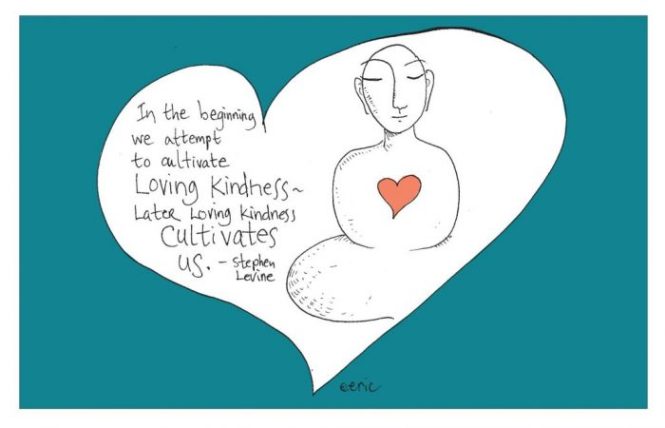
Author’s Note: We originally wrote this article in 2012 after the shooting at Sandy Hook Elementary School. We’re sharing it to our Elephant Journal readers now in the wake of the continued violence.
~
Following the recent shootings, a reader sent an email asking: “What can you say to help me make sense of this event?”
Here’s what I wrote:
I can’t say anything to make sense of this. I believe that seeking to make sense—too quickly—is a way of distancing ourselves from experiencing the impact, the power, and the message that is encoded in this experience.
It’s natural to try to distance the mind and heart. To pull back and protect ourselves when confronted with such rawness and horror. I’ve seen this distancing tendency in myself and my friends.
>> In the spiritual discourse, there is the tendency to weave a metaphysical cocoon around the event, dulling our sensitivity and awareness. This is a way of shutting down, even when it’s framed in the language of opening up.
>> In the political discourse, there’s the tendency to assign blame to the shooter, to one or more political parties, or to the culture. This is a way of lashing out, even when it’s framed in the language of rationality or social justice.
>> For many, the distancing reaction arises as the impulse to stay busy with today’s to-do list, in order to distract attention from the anguish that keeps scratching at the door of the heart.
What about you? How does the distancing reaction shape your thoughts, speech, or actions?
It’s absolutely essential to notice, to name, and to be aware of these distancing tendencies—if you want to create conditions that preclude this kind of event from happening again.
Because if what we think, say, or do is based on distancing, I’m afraid it will never lead to the kind of understanding, dialogue, relationships, or actions that will help to prevent these tragedies. If what we think, say, or do is based on distancing, we will not fully receive the impact of this event, we will not be changed by this event, and we will not change the conditions that generated it.
Distancing strategies—and we all have them—do not transform the situation. They’re not designed to do so. Distancing strategies are designed to reinforce our existing worldview and to perpetuate our conditioned ways of being in the world.
This event deserves more than distancing. It deserves more than formulaic spiritual, psychological, or political understanding. If facing this event confirms what you already know, that knowing will not move the conversation forward. If our collective reaction to this event simply prolongs the familiar perspectives, debates, and actions, we’re going to perpetuate the suffering.
Understanding can come. But only as we open to and fully experience all that arises, all that is evoked, and all that is revealed as we contemplate this event.
This event asks you, me, all of us:
>> How can you meet this event in a way that does more than confirm what you already know, what you already believe?
>> How can we, individually and collectively, take this event so deeply to heart that it overrides strongly held convictions and undermines heavily ingrained habits of distancing?
>> How can I, you, and we meditate upon this tragedy in such a way that creates conditions that preclude it happening again?
These questions can’t be answered by thoughts or emotions, which are heavily conditioned and rooted in the past. We can’t look to our conditioning—including our spiritual and political conditioning—to create new results. Relying on conditioned reactions will only perpetuate the conditions that have given rise to this event.
Can you see that if you respond to this event with a conditioned mind and reactive emotions, you will simply be continuing the legacy of the past?
But how can any of us do otherwise?
What can we do to develop our individual and shared capacity to meet this event—and the experience of unbearable suffering—without the overlay, insulation, and protection that comes from relying on patterns of the past?
All the wisdom traditions agree: for violence to arise, there must be conditions that foster, support, and give rise to violence. Collectively, we have fostered, supported, and given rise to such conditions. That much is obvious. But when we refer to the collective, who or what are we talking about? Certainly, it is a fabric woven of many individual threads.
You are a thread in the collective fabric, as am I.
Neither of us is separate from the collective. The collective is the body, mind, and heart of our inter-being—to use Thich Nhat Hanh’s wonderful phrase. Recognizing the reality of inter-being begs, again, the question:
What can I do—right now—so that my thread weaves the conditions of peace, of healing, and of awakening into the collective fabric?
We need to develop our capacity to meet the gritty, often painful, truth of our experience without being overwhelmed.
Because, when we are overwhelmed, the natural reaction of distancing kicks in. And when this reaction kicks in, you and I fall back on our habitual spiritual, psychological, and political patterns. To let go of these patterns can be terrifying. But the alternative—the perpetuation of the past and the prolonging of the conditions that create such acts of violence—is more terrifying.
Rumi wrote, “The cure for pain is in the pain.”
We need to develop our capacity to enter the pain—with loving awareness.
To enter the pain in our individual body and mind and the pain in our collective soul. How? Through spiritual practice. I believe we need to practice a deeper form of meditation. One that goes beyond stress reduction, beyond the relaxation response, and beyond individual enlightenment.
We need to practice in such a way that we enter into the tangled web of our shared conditioning with loving awareness. Through practice, we can—individually and collectively—untangle the knots of troublesome emotions, and till the swirling of confused thoughts
~
The wisdom traditions all point to a state of consciousness that is capable of healing even the most horrific suffering. This state of consciousness is within you. Spiritual practice cultivates the psychological, emotional, and physical capacity for you to allow that state of healing presence to do its work.
There is a healing presence—a loving awareness—which transcends and can transform your suffering. Whatever is not included in the embrace of loving awareness, whether within you or outside you, will remain in the thrall of the patterns of the past.
Loving awareness is the antidote to distancing.
It embraces everything—not with a sloppy, emotional group hug—but with the fierce compassion and unwavering clarity needed to stop the violence.
Here’s the deal: loving awareness won’t arise in your individual experience through thinking or emoting. It won’t take root in our collective experience through thinking or emoting. For loving awareness to transform suffering, you and I have to embody it. This takes practice.
When you and I practice…we’ll understand. When we understand, we will take action and create the conditions that will make it impossible for this to ever happen again.
Love & Shanti,
E.
~
Relephant:
To Everyone Complaining about the National School Walkout.
What not to call Someone in danger of committing a School Shooting.
What is a Compassionate Response to Violence?
Bonus: Spotlight Interview.
~
Author: Eric Klein
Image: Author’s Own
Editor: Catherine Monkman
Copy & Social Editor: Lieselle Davidson







Read 0 comments and reply